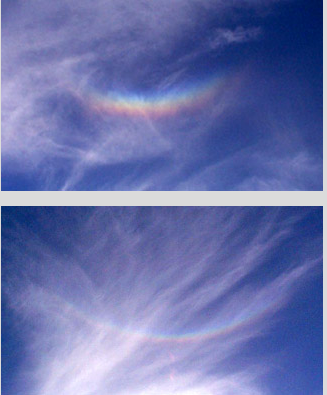Circumzenithal Arcs vs Solar Elevation
Circumzenithal Arcs vs Solar Elevation: A Detailed Analysis
When it comes to atmospheric optics, one fascinating phenomenon that often captures the attention of sky gazers is the appearance of circumzenithal arcs (CZAs). These arcs, also known as Bravais' arcs, form a vivid display of vibrant colors against the backdrop of the sky. However, their characteristics can vary depending on the elevation of the sun. In this article, we will delve into the relationship between CZAs and solar elevation, exploring how these arcs change in shape and size as the sun moves across the sky.
To illustrate the impact of solar altitude on CZAs, let's examine two arcs captured by Michael Ellestad. The first arc, observed when the sun is relatively high in the sky, appears short and broad. In contrast, the second arc, produced when the sun is near the horizon, appears long and narrow. This observation provides a glimpse into how the CZA transforms based on solar elevation.
The shape and size of CZAs are primarily influenced by the angle at which sunlight enters ice crystals in the atmosphere. These crystals act as prisms, refracting sunlight and separating it into its constituent colors. When the sun is high in the sky, sunlight passes through a smaller portion of ice crystals, resulting in a shorter and wider arc. Conversely, when the sun is closer to the horizon, sunlight traverses a larger portion of ice crystals, leading to a longer and narrower arc.
It is important to note that CZAs always appear above the observer's head, opposite to the position of the sun. Therefore, they are most commonly observed when the sun is relatively low in the sky, typically between 22 and 32 degrees above the horizon. This specific range allows for the optimal conditions required for CZAs to form.
The intensity and brilliance of CZAs are also influenced by solar elevation. When the sun is higher in the sky, the light passing through the ice crystals is more concentrated, resulting in a more vibrant and vivid display of colors. On the other hand, when the sun is closer to the horizon, the light is spread out over a larger area, leading to a less intense and slightly washed-out appearance.
In addition to solar elevation, other atmospheric factors can also impact the visibility and characteristics of CZAs. For instance, the presence of high-level cirrus clouds, which consist of ice crystals, can enhance the formation of CZAs. These clouds provide the necessary medium for sunlight to interact with ice crystals and create the distinctive arcs.
Furthermore, the geographic location of the observer can affect the frequency of CZA sightings. Those located at higher latitudes, closer to the polar regions, are more likely to witness CZAs due to the specific atmospheric conditions prevalent in those areas. However, CZAs can occur in any location as long as the necessary combination of solar elevation and ice crystal presence is met.
To summarize, CZAs and solar elevation are intricately linked. The shape, size, intensity, and visibility of these arcs are all influenced by the altitude of the sun in the sky. As the sun moves across its daily trajectory, CZAs transform, showcasing different characteristics depending on its position. Understanding this relationship allows sky enthusiasts to anticipate and appreciate the mesmerizing displays of circumzenithal arcs with a deeper appreciation for the atmospheric phenomena at play.

Two arcs imaged by Michael Ellestad illustrate how the CZA changes with solar altitude.
The top arc from a relatively high sun is short and broad.
The lower arc produced by a sun near the horizon is long and narrow.
Note: this article has been automatically converted from the old site and may not appear as intended. You can find the original article here.
Reference Atmospheric Optics
If you use any of the definitions, information, or data presented on Atmospheric Optics, please copy the link or reference below to properly credit us as the reference source. Thank you!
-
<a href="https://atoptics.co.uk/blog/circumzenithal-arcs-vs-solar-elevation/">Circumzenithal Arcs vs Solar Elevation</a>
-
"Circumzenithal Arcs vs Solar Elevation". Atmospheric Optics. Accessed on November 26, 2024. https://atoptics.co.uk/blog/circumzenithal-arcs-vs-solar-elevation/.
-
"Circumzenithal Arcs vs Solar Elevation". Atmospheric Optics, https://atoptics.co.uk/blog/circumzenithal-arcs-vs-solar-elevation/. Accessed 26 November, 2024
-
Circumzenithal Arcs vs Solar Elevation. Atmospheric Optics. Retrieved from https://atoptics.co.uk/blog/circumzenithal-arcs-vs-solar-elevation/.